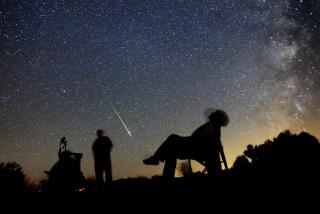Comet Shown Hitting Dark Side of Jupiter
- Share via
From its unique vantage point in space, the Galileo probe Wednesday relayed the first direct evidence from the dark side of Jupiter showing a shattered comet streaking into the planet’s atmosphere, even as the most devastating salvo of comet debris yet began to pummel the planet.
While astronomers around the world gaped at the catastrophe unfolding in the heavens, the scientific fallout on Earth was just beginning.
Scientists at NASA’s Jet Propulsion Laboratory in Pasadena said that the $892-million Galileo probe, which has the only direct view of the fragments as they hit Jupiter’s nightside, had detected the intense flare from two immense chunks of comet Shoemaker-Levy 9 entering the planet’s atmosphere. This was a prelude to what they hope will be actual images of the unusual shooting stars plummeting into Jupiter’s clouds.
The spacecraft’s light-detecting infrared photometer caught the meteoric streaks of Fragment H, which struck Monday, and Fragment L, which hit Tuesday, Terry Z. Martin, JPL science coordinator for the sensor, said Wednesday. The probe, which is scheduled to begin a two-year orbit of the planet in December, 1995, was about 150 million miles from the planet when it recorded the flashes.
Meanwhile, planetary scientists at the Goddard Space Flight Center in Maryland and elsewhere around the country began to sift through mountains of data from the impacts. They are looking for clues to what lies in Jupiter’s hidden depths and to the composition of comets, which scientists believe have been circling the solar system since creation. The results of their research will be hammered out in science journals and astronomy conferences for years to come.
“The best way to see how something works is to give it a poke and see what happens. We just gave Jupiter’s atmosphere a great poke,” said University of Arizona scientist Roger Yelle, who is analyzing spectrograph readings from the Hubble Space Telescope. “Eventually (by analyzing comet debris) we might be able to say something about the composition of the early solar system.”
So far, scientists taking their first detailed look at the roiling clouds of debris have been chagrined to find no trace of water and surprised to discover sulfur. Preliminary analysis has also revealed ammonia, methane and, possibly, hydrogen sulfide.
Finding moisture in Jupiter’s thick atmosphere is important because it would help confirm or refute scientists’ calculations as to how the air on planets is formed and how it evolves. Analyzing the sulfur content could provide clues to the depth to which the fragments penetrated before exploding and to the yellow in Jupiter’s colorful clouds.
University of Arizona astronomers Marcia J. Reike and George H. Reike, however, reported via electronic mail that their observations on the 90-inch telescope at Steward Observatory on Kitt Peak indicate the vast dark plumes on Jupiter are not methane, ammonia or water from deep in the planet’s atmosphere, but dirt and dust from the disintegrating comet.
Based on the preliminary chemical evidence, scientists were not yet completely certain whether Shoemaker-Levy 9 is a true comet--an icy cement of water, carbon dust and boulders from the farthest reaches of the solar system--or a solid, rocky asteroid pulled out of the belt of debris orbiting between Jupiter and Mars, said Lucy McFadden, a University of Maryland scientist. She is coordinating viewing reports from observatories around the world.
As scientists pored through printouts, the bombardment continued.
On Wednesday, five more fragments struck Jupiter, beginning an unusual combination punch. Three of the largest fragments were expected to slam into the same location on Jupiter’s southern hemisphere 10 hours apart Wednesday and early today.
Since the Jovian rotation is 10 hours, each of the fragments will hit at nearly the same spot with a force believed to be equal to the impact of Fragment G, which on Monday produced the largest planetary explosion ever observed. The spreading cloud of debris, dust and hot gas is the most prominent feature astronomers have seen on Jupiter in 300 years of observing the planet, more visible even than the Great Red Spot.
The first of the three major fragments, Q, apparently hit just after 1 p.m. Wednesday. This was expected to be followed by Fragment R 10 hours later and then by Fragment S 10 hours after that, at 8:12 a.m. today.
“We are mostly running around like giddy little kids,” said University of Texas astronomer Anita Cochran at the McDonald Observatory in Ft. Davis, Tex. “It is so much fun to watch Jupiter change before our eyes.”
At the Sutherland Observatory in South Africa, astronomers using an infrared telescope late Wednesday reported a large fireball from what was believed to be the first of the three impacts.
A series of seven images taken by astronomers at the W.M. Keck Observatory on Mauna Kea in Hawaii show that impact sites are still glowing from the immense heat of the explosions this week, even three or four days after the initial collision.
Aboard the National Aeronautics and Space Administration’s Kuiper Airborne Observatory--a C-141 jet which has watched the comet impacts from 41,000 feet off the coast of Australia this week--astronomer Gordon Bjoraker reported measuring extreme temperature changes at each impact point.
“It was like seeing a super nova going off . . . a star going off,” he said.






